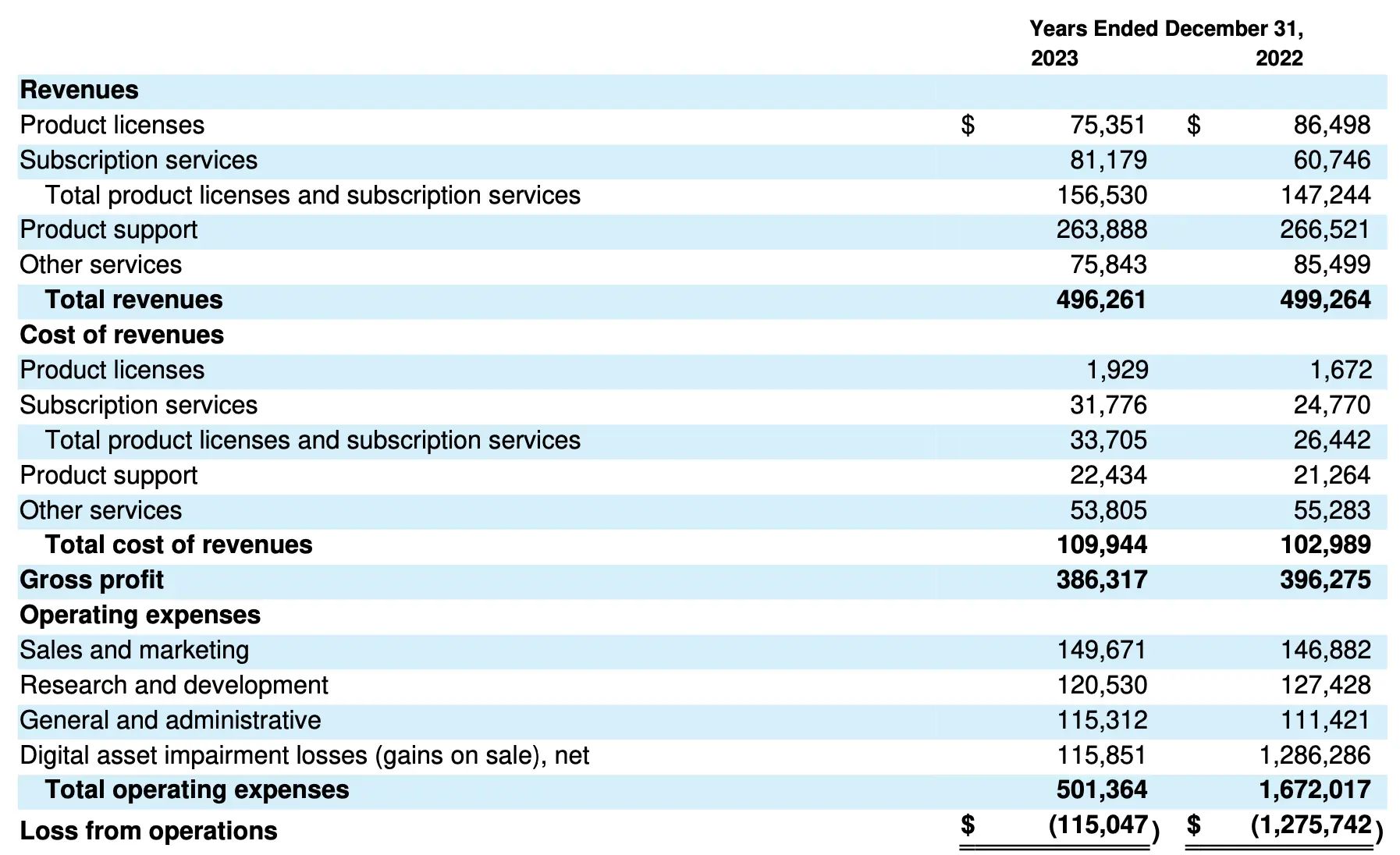The pioneer of incorporating Bitcoin into corporate financial strategy, Microstrategy's journey of Bitcoin investment
Introduction
MicroStrategy is a well-known business intelligence software company founded in 1989, focusing on providing BI software and services, and is currently the publicly traded company with the largest Bitcoin holdings. Its analytics platform has consistently been rated as the best enterprise analytics platform, used by many of the most respected companies in the Fortune Global 500. Since August 2020, the company has been continuously using cash to purchase Bitcoin as its primary reserve asset. In the mid-2020 earnings call, MicroStrategy first disclosed its Bitcoin investment plan, stating that it would invest $250 million in "one or more alternative assets" over the next 12 months, which could include cryptocurrencies like Bitcoin. At that time, the company's market capitalization was approximately $1.1 billion, while today it exceeds $16 billion. This article aims to delve into the development history of MicroStrategy, its Bitcoin investment journey, and the unique investment strategies adopted by the company.
1. Development History of MicroStrategy
MicroStrategy, headquartered in Virginia, USA, was founded in 1989 by MIT graduates Michael Saylor and Sanju Bansal. The company developed an efficient platform for analyzing and visualizing enterprise business data, achieving stable growth and going public on NASDAQ in 1998 under the ticker symbol MSTR. As a pioneer in the business intelligence (BI) field, MicroStrategy provides enterprise-level analytics solutions and mobile software, enabling thousands of organizations worldwide to gain data-driven decision support. In the BI sector, MicroStrategy's main competitors include SAP AG Business Objects, IBM Cognos, and Oracle Corporation's BI platform. In June 2023, MicroStrategy partnered with Microsoft to expand its products on Microsoft Azure and enhance AI capabilities. Through this collaboration, customers can achieve comprehensive management and analysis of data in the cloud, enabling faster and more accurate decision-making. MicroStrategy's development history is filled with innovation and challenges. Since its founding in 1989, it has undergone several significant transformations in the business intelligence (BI) field:
Founding and Early Development (1989-1990s)
- Founding: MicroStrategy was founded in 1989 in Virginia by Michael Saylor and Sanju Bansal, initially focusing on providing business intelligence consulting services.
- Product Development: In the early 1990s, the company began developing its own business intelligence software, which supported data analysis, report generation, and other functions, helping businesses extract valuable information from large datasets.
Leader in Business Intelligence Software (1990s)
- IPO: In 1998, MicroStrategy successfully went public on NASDAQ under the ticker symbol MSTR. The IPO provided the company with capital, facilitating further growth and product development.
- Growth: MicroStrategy quickly gained significant status and success in the business intelligence field due to its strong products and services.
Volatility and Adjustment (2000s)
- Market Volatility: In 2000, the company faced legal challenges and a decline in stock price due to reported accounting errors.
- Adjustment and Recovery: The company gradually restored stability through management team adjustments, product line optimization, and strengthened financial management. Additionally, MicroStrategy began focusing on mobile solutions and cloud services to adapt to market changes.
Transformation and Bitcoin Investment (2010s - Present)
- Technological Innovation: In the 2010s, MicroStrategy continued to innovate its products, launching more business intelligence solutions integrated with mobile technology and cloud computing.
- Bitcoin Investment: In 2020, MicroStrategy began converting a significant portion of its cash reserves into Bitcoin, making a strategic shift that positioned the company as a major corporate Bitcoin holder. This move not only brought financial asset appreciation to the company but also enhanced its image as a forward-looking enterprise.
As a leader in business intelligence (BI), MicroStrategy attracted notable institutional investors, including the world's largest asset management firm BlackRock and the second-largest asset management firm Vanguard Group: In January 2020, Morgan Stanley acquired 11.9% of MicroStrategy's shares. By the first quarter of 2023, Fidelity Investments, managing over $4.5 trillion in assets, significantly increased its stake in MicroStrategy, making it one of the top ten shareholders. According to the 13F quarterly report, BlackRock held approximately 6% of MicroStrategy, valued at over $2.2 billion, while Fidelity increased its holdings by 650,000 shares in the first quarter of 2023, raising its stake to 6.79%. This trend was not limited to the U.S.; Canada's sixth-largest bank, National Bank of Canada, also purchased over $500,000 worth of MicroStrategy stock in the first quarter of 2023, increasing its stake by 8.8%.
2. MicroStrategy's Bitcoin Investment Journey
MicroStrategy made headlines in August 2020 by announcing the purchase of 21,454 Bitcoins for approximately $250 million, stating that digital assets are a reliable store of value and an attractive investment asset with greater long-term appreciation potential than holding cash. This move was not just a one-time purchase but marked the beginning of its systematic Bitcoin investment strategy. Since then, MicroStrategy has continuously increased its Bitcoin holdings, demonstrating its firm belief in Bitcoin's long-term value. Since August 2020, MicroStrategy has become an active Bitcoin buyer, making over 25 Bitcoin investments over three years. This continuous purchasing activity continued into 2024, with MicroStrategy significantly increasing its Bitcoin holdings in March alone: on March 11, it purchased 12,000 Bitcoins, followed by a large transaction of 9,245 Bitcoins on March 19. MicroStrategy's Bitcoin investment history:
August 2020: Initial investment of approximately $250 million to acquire 21,454 BTC at an average price of $11,654.
September 2020: Additional $175 million purchase of 16,796 BTC at an average price of $10,422.
December 2020: Increased investment of approximately $650 million through convertible bond issuance to purchase 29,646 BTC at an average price of $22,000.
June 2021: Acquired 13,005 BTC for $489 million at an average price of $37,617.
November to December 2022: Purchased 2,395 BTC at an average price of $17,871 and sold 704 BTC in December at an average price of $17,800.
March to July 2023: Acquired 6,455 BTC from March 27 to April 5 at an average price of $28,016; purchased 12,333 BTC from April to June at an average price of $28,136; increased holdings by 467 BTC in July at an average price of $30,835.
February 2024: Acquired 3,000 BTC from February 15 to 25 at an average price of $51,813.
March 2024: Purchased 12,000 BTC for $821 million at an average price of $68,400.
MicroStrategy's Bitcoin investment journey reflects its strategies and decisions at different stages, showcasing the company's firm belief in Bitcoin as a store of value and its ability to make strategic investments by leveraging market volatility.
MicroStrategy's Bitcoin investments have yielded substantial returns. Meanwhile, this investment return is also vividly reflected in the company's stock price. In March 2024, amid Bitcoin prices continuously reaching new historical highs, the stock price also hit a new high not seen in the past 24 years. As of March 21, the company's stock price had achieved a 14-fold increase compared to the same period in 2020. MicroStrategy's Bitcoin investment strategy has not only strengthened its financial structure but also made its stock an ideal choice for investors looking to gain indirect exposure to Bitcoin without directly purchasing it. Lance Vitanza, Managing Director of Equity Research at TD Cowen, noted that MicroStrategy provides an attractive channel for investors wishing to invest in Bitcoin, with the buying momentum for its stock primarily driven by investors' interest in holding Bitcoin. By issuing bonds to raise funds for purchasing Bitcoin, this not only increased the attractiveness of its stock but also meant that, as a publicly traded company, MicroStrategy's stock does not incur management fees compared to investing in Bitcoin ETFs. Vitanza believes that especially for those expecting a rebound in Bitcoin prices and planning to hold long-term, choosing MicroStrategy's stock over direct investments in Bitcoin or Bitcoin ETFs, due to its lack of management fees and potential premium advantages, is a reasonable decision.
3. MicroStrategy's Bitcoin Investment Strategy
MicroStrategy's substantial investment in Bitcoin is closely related to CEO Michael Saylor's vision. Saylor is a staunch supporter of Bitcoin, viewing it as a "super asset" and the best reserve asset in human history. In August 2020, Saylor announced that the company would convert most of its cash reserves into Bitcoin to combat the risks of dollar depreciation and inflation while leveraging Bitcoin's growth potential. He set a goal for MicroStrategy to hold at least 100,000 Bitcoins as a long-term strategic investment. To achieve such a large-scale Bitcoin purchase, MicroStrategy reassessed its entire corporate financial strategy. Traditional financial management typically involves holding cash, short-term investments, or bonds, but Saylor believes these assets are devalued by inflation, thus seeking an alternative that can preserve value and grow capital, leading to the emergence of Bitcoin. MicroStrategy's Bitcoin investment strategy combines innovative fundraising methods with forward-looking investment approaches:
PART /1 Funding Sources MicroStrategy's funding primarily comes from three sources: cash reserves generated from its core business activities, debt financing in a low-interest-rate environment, and equity financing. Before 2020, the company accumulated a significant amount of cash reserves, providing a foundation for investment. Additionally, the company raised funds through issuing convertible bonds and other means to support its Bitcoin purchasing plans, demonstrating its firm commitment to Bitcoin investment.
PART /2 Investment Methods MicroStrategy adopted a diversified investment strategy to optimize its Bitcoin holdings:
- Bitcoin as Financial Reserve: The company regards Bitcoin as its primary financial reserve asset, marking its trust in it as a long-term store of value.
- DCA (Dollar-Cost Averaging) Purchases: Through a dollar-cost averaging strategy, MicroStrategy gradually built its Bitcoin holdings at different price points, mitigating the impact of price volatility.
- Financial Derivative Operations: To hedge against Bitcoin investment risks, the company employs strategies such as buying put options and selling call options to protect investment value.
- Development of Bitcoin-Related Products: Exploring Bitcoin and Lightning Network technologies to develop new software products and services, expanding the company's business scope.
PART /3 Debt Financing and Regulatory Compliance
In a low-interest-rate environment, MicroStrategy utilized debt financing methods such as issuing convertible bonds, which not only provided funds for purchasing Bitcoin but also enhanced the potential for investment returns. At the same time, the company strictly adheres to Know Your Customer (KYC) and Anti-Money Laundering (AML) standards to ensure its Bitcoin investment activities comply with relevant regulatory requirements. Through these strategies, MicroStrategy has not only strengthened its financial foundation but also established a leadership position in the field of crypto asset investment, demonstrating how to effectively leverage the potential of crypto assets to bring long-term value to enterprises in the modern financial ecosystem. Financial analysis reveals the necessity for MicroStrategy to seek a balance between potential high returns and high risks. During periods of rising Bitcoin prices, the company's asset value has significantly increased. However, the high volatility of Bitcoin also poses challenges to the company's financial stability, exposing it to the risk of financial losses. The 2023 balance sheet shows that although the company holds digital assets valued at $3.626 billion, it has incurred cumulative impairment losses of $2.269 billion due to Bitcoin price fluctuations. Furthermore, the impairment losses of crypto assets account for a significant portion of total operating expenses, particularly pronounced during periods of declining Bitcoin prices, such as in 2023, where impairment losses accounted for 23.1% of operating expenses, and in 2022, it was as high as 76.9%.  MicroStrategy's Bitcoin stock situation at the end of the past three years - Data Source: MicroStrategy
MicroStrategy's Bitcoin stock situation at the end of the past three years - Data Source: MicroStrategy  MicroStrategy's profit and loss situation - Data Source: MicroStrategy
MicroStrategy's profit and loss situation - Data Source: MicroStrategy
4. Conclusion
Through its steadfast investment in Bitcoin and meticulous strategies, MicroStrategy has not only solidified its position as a leader in the crypto asset field but also exemplified how to effectively leverage the potential of crypto assets to bring long-term value to enterprises in a turbulent crypto market. Despite facing challenges from the high volatility of Bitcoin prices, the company has achieved significant investment returns, thanks to its profound understanding of crypto market trends and diversified risk management strategies, while enhancing the robustness of its finances. Looking ahead, MicroStrategy intends to deepen its footprint in Bitcoin investment, continuously exploring and expanding its potential in the crypto economy to solidify its leading position. In the face of the ongoing evolution of the crypto market and new opportunities brought by technological innovation, MicroStrategy must maintain keen market insights and flexible strategic adjustments to ensure steady progress in the wave of the digital economy, achieving sustained growth and success. (This article is for opinion sharing only and does not constitute investment advice.)
REFERENCE [1]" MicroStrategy Announces Third Quarter 2023 Financial Results ", MicroStrategy Announces Third Quarter 2023 Financial Results; Now Holds 158,400 BTC in Total. Accessed 1 Nov. 2023. [2]"MicroStrategy strengthens Bitcoin position with $623M purchase", https://in.investing.com/news/microstrategy-strengthens-bitcoin-position-with-623m-purchase-4077533. Accessed 19 Mar. 2024.
[3]" How Does Microstrategy Buy So Much Bitcoin ?", https://www.altcoinbuzz.io/cryptocurrency-news/how-does-microstrategy-buy-so-much-bitcoin. Accessed 25 Sep. 2023.
[4]" MicroStrategy Owns About 1% of All Bitcoin With Latest Purchase ", https://www.bloomberg.com/news/articles/2024-03-19/microstrategy-owns-about-1-of-all-bitcoin-with-latest-purchase-mstr. Accessed 19 Mar. 2024.











